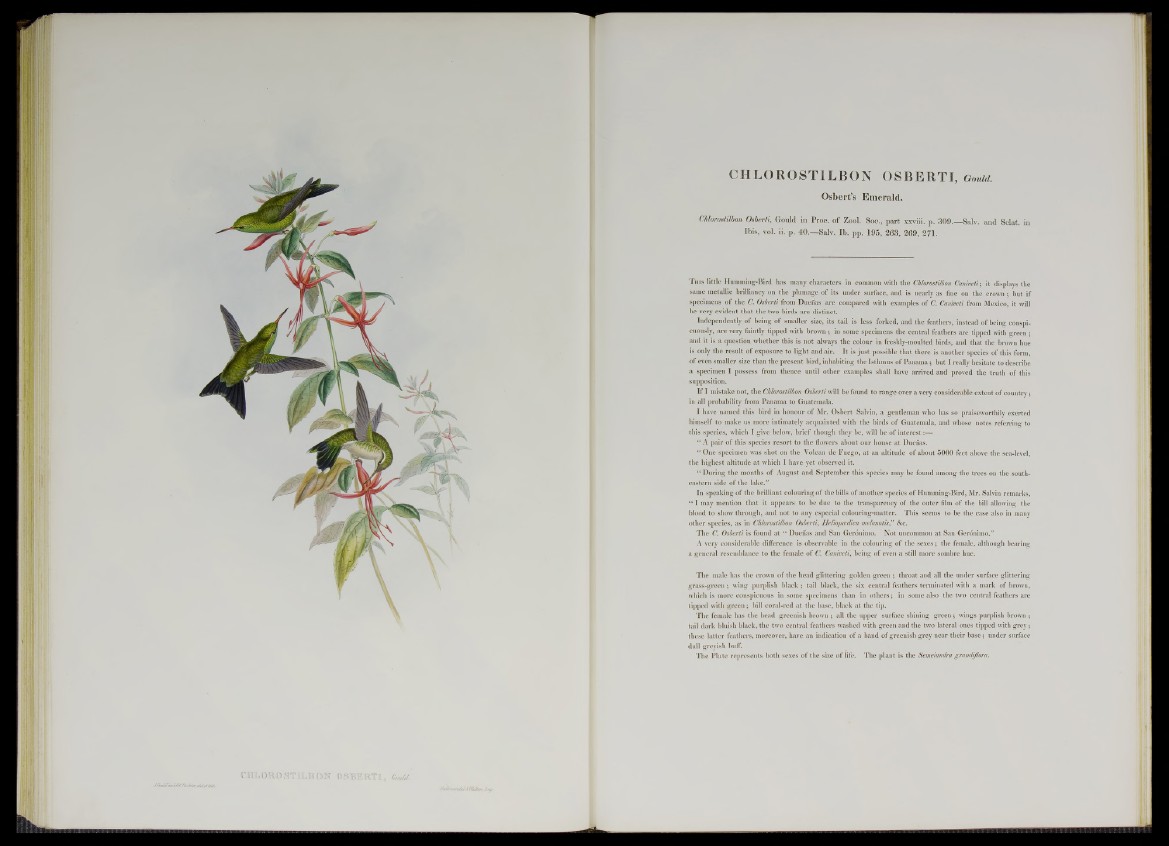
CHEOROOTELBON OSBERTI» GouU.
CHLOROST1LBON OSBERTI, Oouid.
Osbert’s Emerald.
Chlorostilbon Osberti, Gould in Proc. o f Zool. Soc., p a rt xxviii. p. 309.—Salv. and Sclat. in
Ibis, vol. ii. p. 4 0 .— Salv. Ib. pp. 195, 263, 269, 271.
T h i s little Humming-Bird has many characters in common with the Chlorostilbon Caniveti; it displays the
same metallic brilliancy on the plumage of its under surface, and is nearly as fine on the crown; but if
specimens of the C. Osberti from Dueñas are compared with examples of C. Caniveti from Mexico, it will
be very evident that the two birds are distinct.
Independently of being of smaller size, its tail is less forked, and the feathers, instead of being conspicuously,
are very faintly tipped with brown; in some specimens the central feathers are tipped with green ;
and it is a question whether this is not always the colour in freshly-moulted birds, and that the brown hue
is only the result of exposure to light and air. It is just possible that there is another species of this form,
of even smaller size than the present bird, inhabiting the Isthmus of Panama; but I really hesitate to describe
a specimen I possess from thence until other examples shall have arrived and proved the truth of this
supposition.
If I mistake not, the Chlorostilbon Osberti will be found to range over a very considerable extent of country;
in all probability from Panama to Guatemala.
I have named this bird in honour of Mr. Osbert Salvin, a gentleman who has so praiseworthily exerted
himself to make us more intimately acquainted with the birds of Guatemala, and whose notes referring to
this species, which I give below, brief though they be, will be of interest:—
“ A pair of this species resort to the flowers about our house at Dueñas.
“ One specimen was shot on the Volcan de Fuego, at an altitude of about 5000 feet above the sea-level,
the highest altitude at which I have yet observed it.
“ During the months of August and September this species may be found among the trees on the southeastern
side of the lake.”
In speaking of the brilliant colouring of the bills of another species of Humming-Bird, Mr. Salvin remarks,
“ I may mention that it appears to be due to the transparency of the outer film of the bill allowing the
blood to show through, and not to any especial colouring-matter. This seems to be the case also in many
other species, as in Chlorostilbon Osberti, Heliopcedica melanotis,” &c.
The C. Osberti is found at “ Dueñas and San Gerónimo. Not uncommon at San Gerónimo.”
A very considerable difference is observable in the colouring of the sexes; the female, although bearing
a general resemblance to the female of C. Caniveti, being of even a still more sombre hue.
The male has the crown of the head glittering golden green ; throat and all the under surface glittering
grass-green; wing purplish black ; tail black, the six central feathers terminated with a mark of brown,
which is more conspicuous in some specimens than in others; in some also the two central feathers are
tipped with green; bill coral-red at the base, black at the tip.
The female has the head greenish brown ; all the upper surface shining green; wings purplish brown ;
tail dark bluish black, the two central feathers washed with green and the two lateral ones tipped with grey;
these latter feathers, moreover, have an indication of a band of greenish grey near their base; under surface
dull greyish buff.
The Plate represents both sexes of the size of life. The plant is the Semeiandra grandiflora.